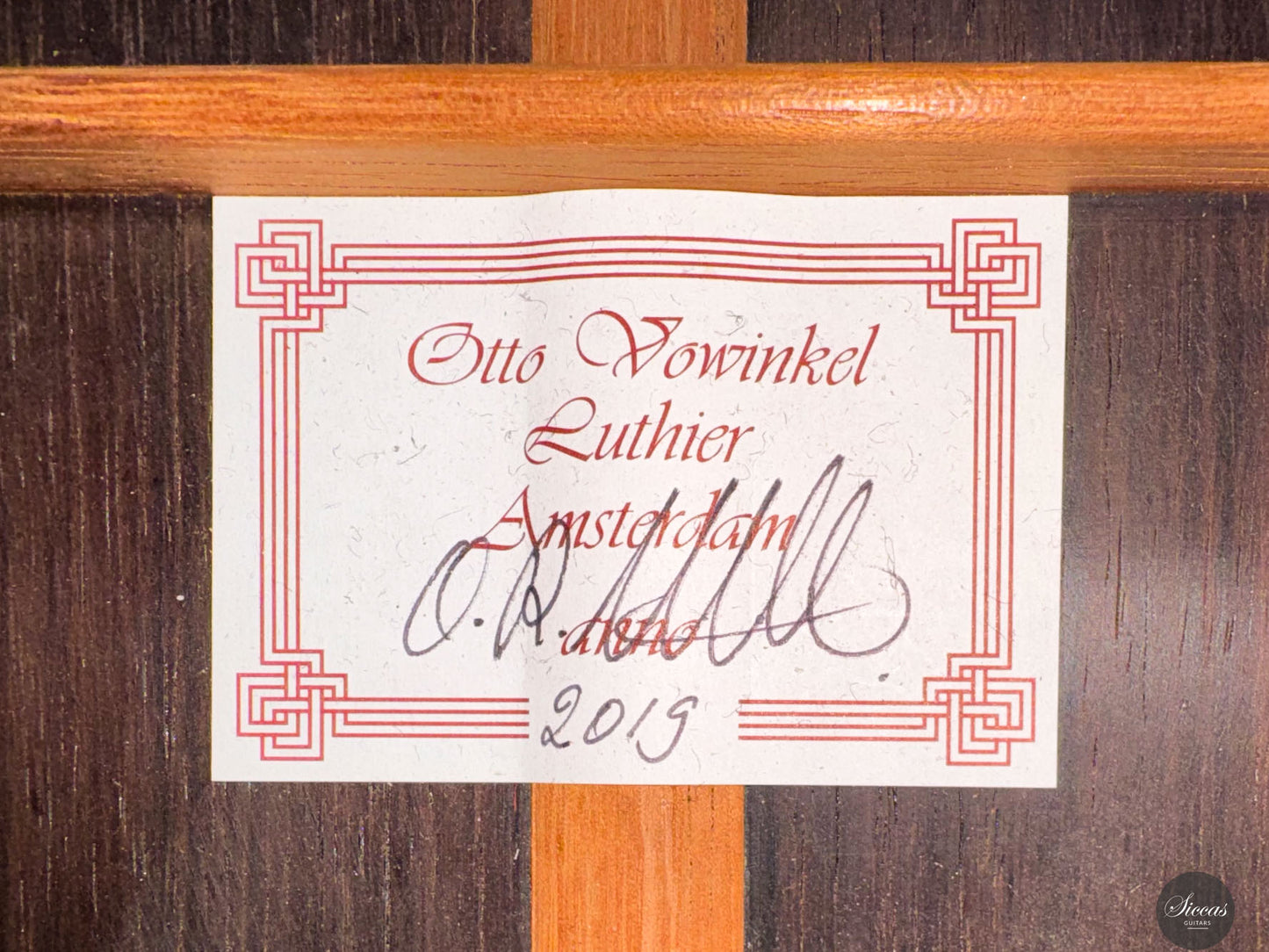Otto Vowinkel - 2019 - Concert
Otto Vowinkel - 2019 - Concert
Details
Details
Overview
Overview
Shipping important note
Shipping important note
Delivery times are typically reliable and most instruments arrive within the estimated timeframe.
Should any unexpected delay occur, our team will keep you informed and provide support at every step. For all shipping details and exceptions, please see our Shipping Policy.
Details about GPSR
Details about GPSR
























More details about the guitar
About the luthier
Otto Vowinkel was born and raised in the historic center of Amsterdam, in a family of tailors. His first guitar was built in 1984, inspired by the book “Classical Guitar Construction” by Irving Sloane. With only basic tools and an old pool table as a workbench, he began building guitars in the attic of his home. Lacking formal training, he improved by showing his early instruments to experienced guitarists, integrating their feedback into each new build.
In 1989, he began a long and influential collaboration with Dutch luthier Alex ‘Alejandro’ van der Horst (1959–2009). Together, they refined their shared vision of the ideal instrument: one with a flexible tone, fast response, and clarity of sound as the true driver of projection. Over the years, Otto Vowinkel has developed into a highly respected guitar maker, known worldwide for his traditionally built concert instruments characterized by clean aesthetics, exceptional balance, and playability.
About the guitar
This 2019 Otto Vowinkel Concert guitar represents the top tier of his production, a model designed for the needs of professional performers. It combines substantial projection with physical lightness, delivering outstanding response with minimal effort. Tonally, it offers evenness across all registers, refined sustain, and remarkably precise intonation, making it a highly expressive and controllable instrument under the hand.
The top is made of cedar, carefully selected for its richness and color depth, paired with Madagascar rosewood back and sides. The internal structure follows a traditional seven-fan bracing pattern that contributes to the instrument’s clarity and tonal separation. The result is a guitar that can deliver both warmth and brilliance, depending on the player’s input.
The French polish shellac finish adds a soft luster while preserving the instrument’s acoustic sensitivity. Unique aesthetic details include the rosette, featuring the triple-cross motif from the flag of Amsterdam, and the headstock, which is carved after the architectural facade of Vowinkel’s workshop in Amsterdam.
Condition
This guitar is in excellent condition, with only minimal signs of playing. The structure, finish, and setup are fully intact. It is equipped with Sloane tuning machines and comes in a Hiscox Pro II case.
Regular care extends the life of the instrument
Even with careful use, a classical guitar may gradually change in appearance or respond to unstable storage conditions. Have a close look at your guitar regularly and be attentif to changes. If your instrument is suffering from its environement, it will let you know.
Protect Your Guitar: Handle with Care
Be mindful when touching your instrument with greasy or unwashed hands: any skin contact is a small attack on the varnish. Of course, a guitar is made to be played, but taking a few precautions helps preserve its beauty: wash your hands before playing, wear long sleeves, and avoid unnecessary direct skin contact with the body of the instrument.
Pro tip: Avoid playing with a button-up shirt, heavy jewelry, or a belt, as these can scratch the guitar. Also, make sure your guitar case is free of any objects that could damage the instrument during storage.
String care
A good habit to adopt is wiping down your strings briefly after each playing session. This small action significantly extends their lifespan and helps maintain a consistent, comfortable feel under your fingers.
Most importantly, clean strings are essential for keeping your instrument in tune. Corrosion, sweat, and dust can affect the uniformity of the strings and interfere with accurate tuning across the entire fingerboard.
Pro tip: If you're having trouble getting your guitar in tune, it might be time to change the strings. A useful test is to compare the pitch of the 12th fret harmonic with the fretted note at the 12th fret; if there's an unusually large gap between them, your strings may have lost their integrity and should be replaced.
Keep Your Shellac Finish Shining!
Got a guitar with a shellac (French polish) finish? Here's a simple trick: Take a clean microfiber cloth and gently breathe on the surface to create a light mist. Then, softly rub to remove fingerprints, sweat, and grease. That’s usually all it takes to keep it looking great, no products needed!
Pro tip: Every few years, treat your guitar to a check-up with a luthier to keep it in top shape.
Storing Your Guitar: Climate Matters
Your guitar can safely stay outside its case, as long as the surrounding environment maintains 42–55% humidity and a temperature between 18–25°C.
Keep in mind that humidity levels can still fluctuate inside the case, especially during seasonal changes.
- Too much humidity may cause overtightened strings and a dull tone.
- Too little humidity can lead to a bulging top, string buzz, or even cracks.
Avoid placing your guitar near radiators, air conditioners, or windows with direct sunlight.
Pro tip: Always close your guitar case while playing. This helps preserve a stable microclimate inside the case, so your instrument is protected the moment you put it back in.

















































